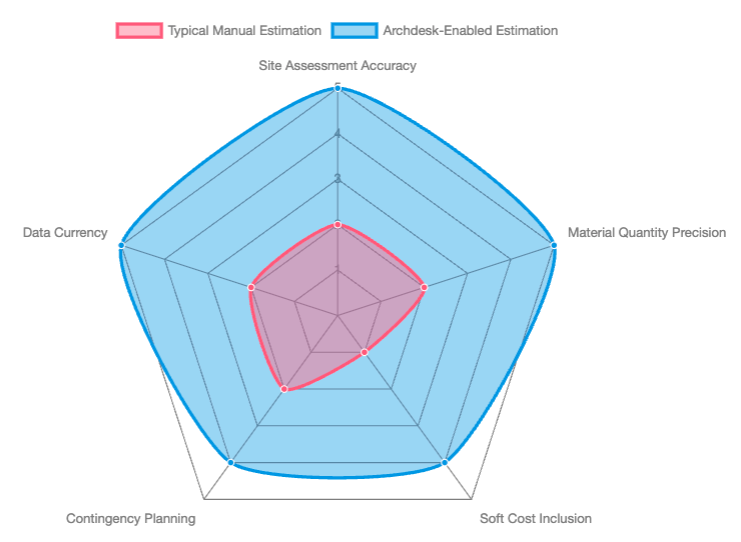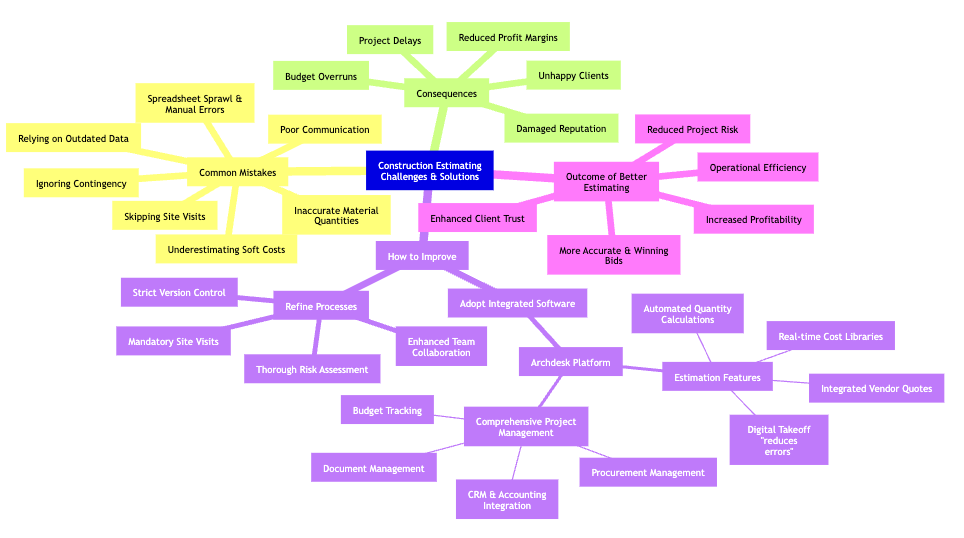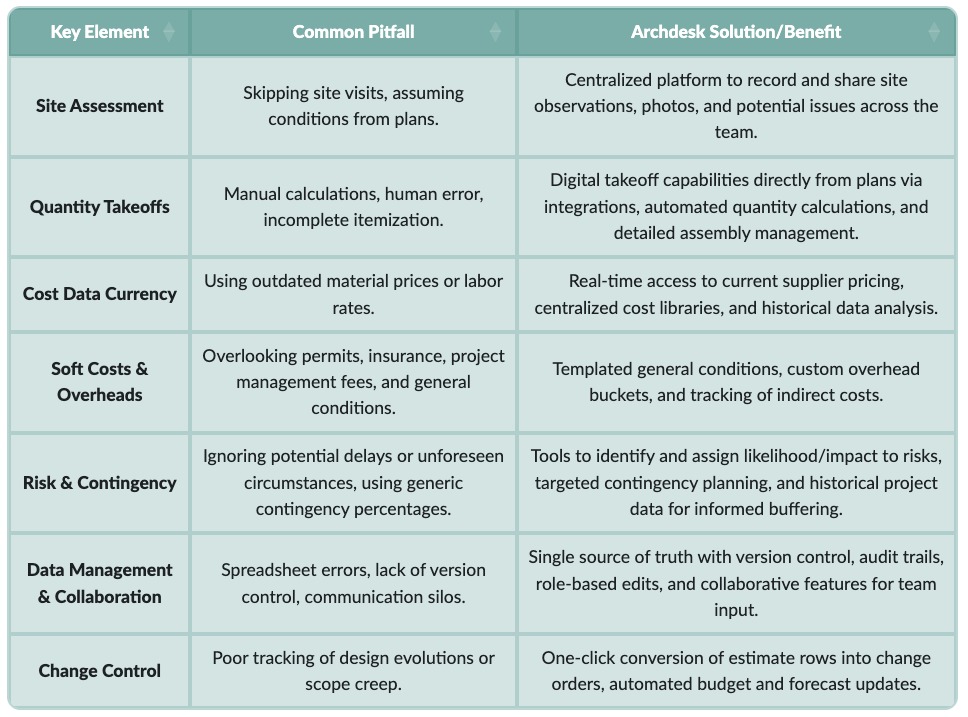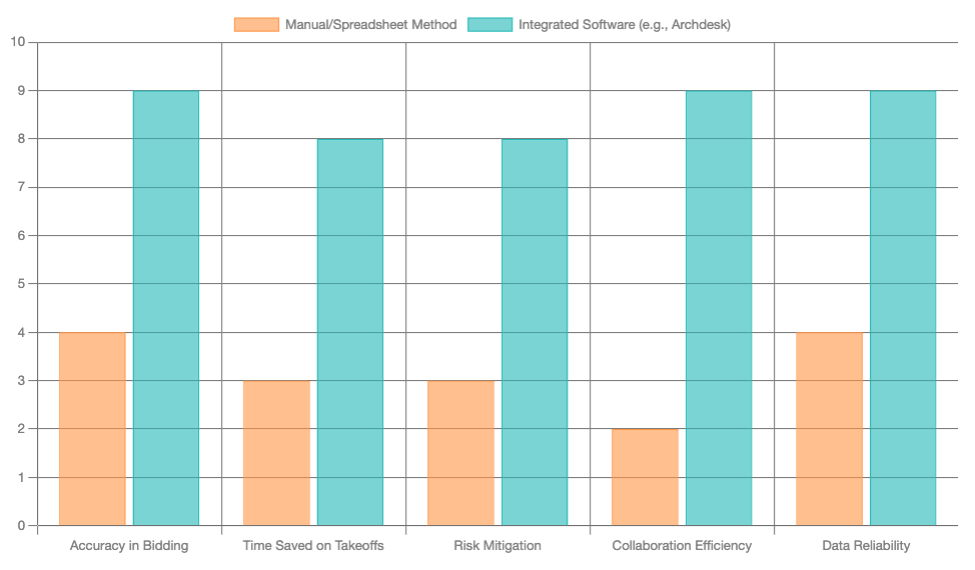Construction, bless its heart, is a tough business. Every project, big or small, kicks off with an estimate, and getting that number just right? Honestly, it often feels like trying to nail jelly to a wall. A tiny miscalculation, and suddenly you're staring down the barrel of budget overruns, disgruntled clients, and projects that drag on longer than they should. It's enough to make even the most seasoned construction pro lose a bit of sleep.
But hey, it doesn’t have to be this way. Let's talk straight about some of the most common estimating blunders and, more importantly, how you can avoid them, turning those shaky guesses into solid predictions. The goal here isn’t perfection, that’s a fool’s errand, but rather confidence and accuracy.
The Sneaky Traps: Where Estimates Go Wrong
Most estimation mistakes aren't massive, glaring errors. They're often small oversights that, when stacked together, create a mountain of trouble. Think of it like a tiny crack in a foundation; ignored, it eventually brings the whole house down.

Miscalculations can lead to significant construction project overruns.
Skipping the Site Visit: A Blind Leap of Faith
Why it's a critical error
This might seem like a no-brainer, but you’d be surprised how often it happens. Relying only on blueprints and specifications without actually setting foot on the project site is like trying to navigate a new city with a map from 1998. You're going to miss crucial details: that tricky access road, the unexpected rock formation, or the existing utilities not marked on the plan. These aren't minor details; they can fundamentally alter your material, labor, and equipment needs.
A quick site visit can reveal so much. Maybe it’s a tight alley for deliveries, or perhaps the soil conditions demand extra groundwork. Maybe there's restricted crane access. These observations can make the difference between a smooth project flow and bringing in a dozen extra trucks of gravel, or dealing with unexpected delays. It's about seeing the ground truth, not just the paper version.
Seriously, walk the job. Take photos. In a platform like Archdesk, you can even tag those images to specific estimate items, so access constraints show up as dollars, not as nasty surprises later on.
Material Mayhem: Getting Quantities Wrong
The takeoff dilemma
This is often the core of the problem, isn't it? The takeoff. It's detailed, precise work, and it's incredibly easy to miscalculate. Underestimate, and you’ll find yourself scrambling for materials, paying rush fees, and delaying the whole project. Overestimate, and you’ve got capital tied up in unused stock, sitting idle in a yard, gathering dust.
Many estimators still wrestle with manual takeoffs or clunky spreadsheets. These methods are full of opportunities for formula errors, miscommunications, and simple human mistakes. It’s a system built on hoping you copied that number correctly. Imagine the time saved and accuracy gained if you could perform digital takeoffs directly from plans, linking those quantities to real-time supplier pricing. It cuts down the guesswork and those frantic, last-minute calls to suppliers.
Underestimating Soft Costs: The Hidden Drain
Beyond bricks and mortar
We tend to zero in on the big-ticket items: concrete, steel, lumber. But what about all the other stuff? Permits, inspection fees, insurance for that specific job, the project management hours spent untangling unforeseen issues? These "soft costs" are often an afterthought, tacked on with a generic percentage. That’s a dangerous game.
Every project has its own unique administrative footprint. A renovation in a historic district, for example, will have entirely different regulatory hurdles than a new build on a greenfield site. Failing to account for these properly can make a healthy-looking margin evaporate before the first shovel hits the dirt. A robust estimation process, supported by a platform that tracks these details from past projects, helps you paint a much clearer picture of the total cost, not just the obvious ones.
Ignoring Contingency: The Illusion of Certainty
Planning for the unplanned
Some folks view a contingency fund as a sign of a weak estimate. But honestly, I see it as a sign of experience and wisdom. Construction operates in a world of variables. Weather delays, supply chain hiccups, a sudden need for a specialist subcontractor – these things happen. It’s not about if, but when.
The mistake isn't having a contingency; it's how you calculate it. A flat 10% across the board isn't strategic. A complex, multi-phase project in a dense urban area carries far more inherent risk than a straightforward, repetitive build. Your contingency should reflect that specific risk profile. It's not a slush fund; it’s a strategic buffer that prevents a few surprises from derailing your entire budget and schedule.
Outdated Data: Building on Shaky Ground
The moving target of prices
Remember the rollercoaster ride of lumber prices a few years back? If your material database hadn’t been updated since before that, your estimates were pure fantasy. The market for materials and labor isn’t static; it breathes, it shifts, and sometimes, it has a full-blown panic attack. Relying on old cost books or last year's supplier quotes is a surefire way to miss the mark. The best estimators keep a finger on the market's pulse and use tools that connect them to current pricing. It’s about building your numbers on what things cost now, not what they cost six months ago.
Spreadsheet Sprawl: A Breeding Ground for Errors
The hidden dangers of manual data
For a long time, spreadsheets were our go-to. And for some simple tasks, they’re fine. But for complex construction estimating? They can be a nightmare in disguise. Manual data entry, the lack of real-time updates, and frankly, the sheer potential for human error – a misplaced comma or a broken formula can throw off an entire project. Plus, trying to collaborate on a massive spreadsheet? Forget about it. It’s hard to track who changed what, and security isn't great either.
Spreadsheets often lead to "version 17 final final.xlsx," and who knows which one is truly correct? Estimating needs version control, audit trails, and role-based edits. Without a centralized system, insights from field teams might be missed, turning small oversights into big overruns. This communication gap is a silent killer of accuracy.

Effective communication between field and office is vital for accurate estimating.
Turning the Tide: Strategies for Spot-On Estimates
So, how do we dodge these common bullets and create estimates that actually make sense? Well, this is where having the right tools and processes makes all the difference. Think about it: a skilled carpenter wouldn’t try to build a house with just a hammer, right? Estimating is no different.
Embracing Technology: The Archdesk Advantage
Why integrated software makes a difference
Construction management software, especially one designed with estimating at its core, can truly revolutionize your process. Take Archdesk, for instance. It's not just another software; it’s a comprehensive platform built specifically for the demands of construction. It streamlines everything from tender to handover, ensuring your estimates are not just accurate, but also efficient.
With Archdesk’s Estimation feature, you’re no longer wrestling with spreadsheets or relying on outdated price lists. It gives you a centralized platform to manage all aspects of cost estimation. We're talking accurate cost breakdowns for materials, labor, equipment, and overhead – all in one place. It uses digital takeoff capabilities, detailed cost analysis, and automated quantity calculations. This means less manual grunt work and a much higher degree of accuracy.

This radar chart illustrates the difference in estimation accuracy across key metrics when comparing traditional manual methods versus using an integrated platform like Archdesk. A higher score (closer to 5) indicates greater precision and effectiveness.
Streamlining the workflow
Imagine speeding up your sales cycle and winning more projects because your pricing is consistently spot-on. Archdesk helps you do just that. It integrates critical elements like budget tracking, accounting, CRM, equipment tracking, and purchase orders. It’s an all-in-one solution that covers everything from pre-construction activities like estimating and bidding, right through to managing project progress and job costs.
When you use a tool like Archdesk, you’re not just getting software; you’re adopting a system that helps you sidestep those common mistakes we talked about. It ensures accurate material quantities, keeps your pricing current, and provides the real-time data you need. You can create detailed estimates, prepare winning bids, and analyze project costs with confidence, without the complexity of juggling multiple disconnected tools.
Regional Nuances: Adapting to Local Realities
Geography matters
It's worth a quick mention that different regions have their own quirks that can impact estimates. In Europe, for example, procurement cycles can sometimes be slow; it pays to index your estimate to inflation clauses where possible. In the GCC, intense heat schedules and Ramadan hours often hit productivity, so you need to plan labor factors realistically. And in North America, Authority Having Jurisdiction (AHJ) permitting variance is a very real thing; always build in soft-cost and time buffers for regulatory hurdles.
The Power of a Unified Platform
There are strong tools out there, no doubt—Procore, Autodesk Construction Cloud, Buildertrend—they all have their merits. But for estimating that's truly tied into live project controls, Archdesk really stands out.

This mindmap illustrates the common pitfalls in construction estimating, their consequences, and how integrated software solutions, particularly Archdesk, can provide comprehensive remedies and lead to better project outcomes.
You know what? Estimating isn’t just about being clever; it’s about being consistent. Standardize your process, store your intelligence, and make it repeatable. That’s how you win more bids and actually keep the margin you priced for.
Key Elements for Better Estimates
To avoid those headaches and keep your projects on track and profitable, there are a few core areas you really need to nail down. These elements form the bedrock of accurate and reliable estimates.

Quantifying the Impact: Accuracy vs. Effort
It's not just about avoiding mistakes; it's about optimizing the process. The right tools can drastically improve accuracy while reducing the sheer effort involved.

This bar chart compares the performance of manual/spreadsheet methods versus integrated software in various aspects of construction estimating, on a scale of 0 to 10. Higher scores indicate superior performance.
FAQ: Your Estimating Questions Answered
What's the biggest mistake in construction estimating?
Honestly, there isn't one single "biggest" mistake, but a combination of several small ones. Skipping site visits, relying on outdated data, and not properly accounting for soft costs or contingencies are frequent culprits that can quickly snowball into significant budget overruns.
How important are site visits for accurate estimates?
Site visits are absolutely critical. They reveal real-world conditions like difficult access, hidden obstacles, or unexpected soil issues that simply can't be gleaned from blueprints alone. Missing these details almost always leads to unforeseen costs and delays later on.
Can I still use spreadsheets for my estimates?
While spreadsheets are familiar, for complex construction projects, they're often a source of error due to manual data entry, lack of real-time updates, and poor version control. Specialized software like Archdesk offers a more robust, accurate, and collaborative solution, reducing the risks inherent in spreadsheet-based estimating.
How much contingency should I include in my estimate?
A blanket percentage isn't ideal. Your contingency should be strategic, reflecting the specific risk profile of each project. Complex projects in dense urban areas, for example, will generally require a higher contingency than simpler, repetitive builds. Tools that help you assess risks can guide this more accurately.
In Conclusion: Build Confidence, Not Just Buildings
Ultimately, getting the estimate right isn't just the first step to winning a job; it’s the crucial first step to successfully finishing it, on time and within budget. It's about replacing uncertainty with confidence. And honestly, that often begins by moving beyond outdated methods and embracing dedicated systems built for the real-world complexities of construction. Accurate estimating isn't just good for your bottom line; it builds trust with clients and solidifies your reputation in a competitive industry.
References
Archdesk Construction Management Software | Archdesk
Cost Estimation in Public Works Projects: Error or Lie? - Reddit
Still Wrestling with Excel for Estimates? There's a Better Way, Mate!
How often do you miss things? : r/estimators - Reddit
12 Best Construction Estimating Software and Tools (2025) - Archdesk
The Five Biggest Errors Construction Estimators Are Making (and ...
The Top 10 Construction Estimating Mistakes
How do homeowners protect themselves from cost overruns ... - Reddit





